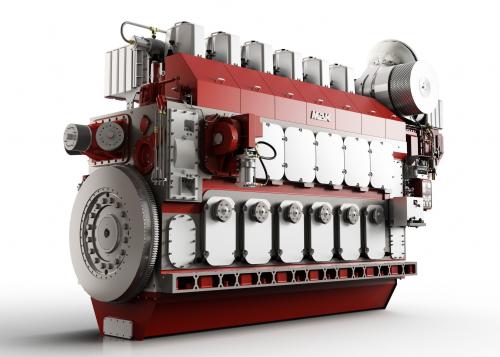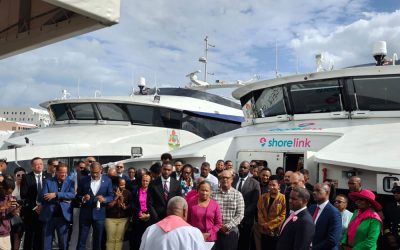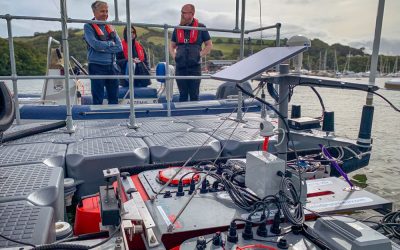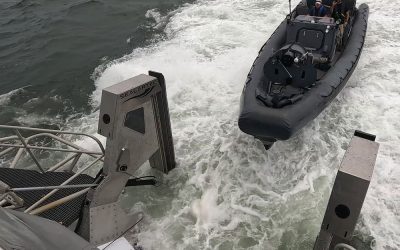Among the firsts is an all-Japanese affair and was the initial order for Yanmar’s 6EY22ALDF dual-fuel engines. The engines will be used in genset configuration on board an LNG-fuelled large coal carrier being built for Mitsui O.S.K. Lines by Namura Shipbuilding. Their ability to run on both diesel and environmentally friendly LNG allows them to satisfy IMO NOx Tier rules as necessary.
With features such as load fluctuation tracking and high thermal efficiency, in addition to precision air-fuel ratio control technology, 6EY22ALDF engines always maintain optimum combustion, enabling them to deliver stable, highly reliable operation.
The 6EY22ALDF engine is the smallest in the company’s range of dual-fuel offerings and is intended only for use as an auxiliary rather than propulsion. As the name suggests it is a six-cylinder in line engine with a bore of 220mm and a stroke of 320mm. Running at 900rpm it has a shaft output of 1,100kW.
Last December, Meyer Turku delivered the 181,808gt Mardi Gras to Carnival Cruises as the owners fourth LNG-fuelled vessel but the first in the Excel-class, a subclass of the Excellence class. The ship’s delivery was delayed for several months because of the Covid pandemic and with cruising shut down the vessel’s entry into service was delayed until the summer.
As well as being the largest vessel in the Carnival fleet, the ship is also the first LNG-fuelled vessel to operate in the US cruise market. The ship is powered by four MaK 16M46 DF engines with operation on LNG allowing the ship to fully meet the requirements for NOx and Sox rules of the US ECAs.
Caterpillar, which owned the MaK, brand, was keen to boast of Mardi Gras’ arrival on the US cruise scene and pledged its continuous support for the ship and other MaK engine owners but for some that would ring a little hollow. Earlier in the year, Caterpillar had let it be known that it was phasing out production of the MaK engines.
The decision means that after a quarter of a century Caterpillar’s involvement in power and propulsion in Europe will have come to an end. MaK was purchased by Caterpillar from the Krupp Group in 1997 and two years later acquired the Warnemünde engine assembly plant from Diesel Motorenwerk Rostock.
In 2013, Caterpillar increased its European interest with the purchase of Swedish propeller, thruster and control systems maker, Berg. Last year the business was acquired by former Berge Propulsion COO Stefan Sedersten and continues in operation in Sweden having dropped its Singapore manufacturing facility.
MaK had a range of four engine types with bores of 20, 25, 32 and 46cm. The engines were in various configurations including vee types and dual-fuel variants. It is possible that a new owner may be found for the business, but the decision by caterpillar comes at an awkward time for an engine maker when future development is seen as vital.
Rolls-Royce exits
The other long-established name to disappear from the medium speed sector is Rolls-Royce. After divesting its commercial marine operations to Kongsberg Group in 2018, Rolls-Royce retained its power division producing high speed mtu engines in Germany and Bergen medium speed engines in Norway.
In August, Rolls-Royce announced it had found a new buyer in UK-based defence and general engineering contractor Langley Holdings and had agreed a sale price of US$75M. “The agreed sale of Bergen Engines is a part of our ongoing portfolio management to create a more focused group and follows a strategic review of Bergen Engines. It contributes towards our target to generate at least £2bn from disposals, as announced last year,” a Rolls-Royce statement said.
The sale includes the Bergen Engines factory and associated facilities in Norway along with the design and global service network. Langley Holdings CEO Anthony Langley says: The acquisition of Bergen Engines is a strategic step in the development of our power solutions division, and I am looking forward to welcoming the 900 plus employees of Bergen Engines to our family of businesses”.




